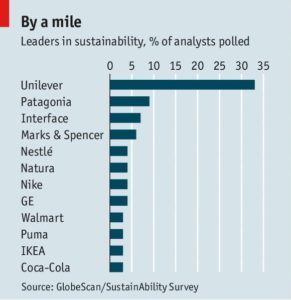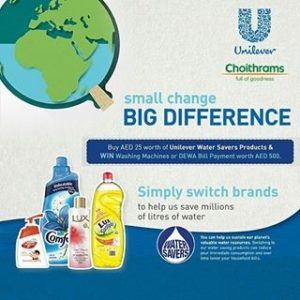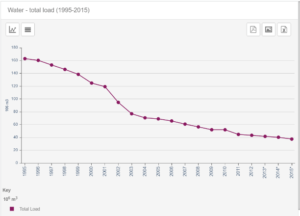Unilever, a company for shareholders and environmentalists alike?

Unilever, a company for shareholders and environmentalists alike?
When Unilever’s CEO, Paul Polman, took the top seat in 2009 he spent a night in the founder’s bed to immerse in the history of his new empire. William Lever had pioneered the paternalistic business model. He campaigned for state pensions for the elderly and even provided schooling, health care and good wages at palm-oil plantations in the Congo.[1] Polman came out of the experience certain that Unilever needed to reconnect with its roots and be a leader not only in the market but also in realms of sustainability – not as an act of charity but because it made business sense. He set out Unilever’s Sustainable Living Plain in 2010 and his efforts have earned him popular support. A survey of “sustainability experts” by GlobeScan, a consultant, done at that time had ranked Unilever first by a wide margin (see chart). Unilever’s plan may also have boosted the company’s share price at a time when its biggest rival, Procter & Gamble, lost its way and ultimately its boss. A more recent look in 2015 showed sales were up 4.1 per cent; operating margins and dividends both rose.[2]
How does Unilever do this when so many other companies are floundering in this area? The company had figured early on that as much as 53%[3] of its sales were derived from emerging markets that are severely impacted by environmental degradation and climate change. And one of the most critical problems brought on by climate change is water stress[4]. As Unilever puts it “We see consequences for our business if we don’t adapt to this new reality. The product categories in which we operate consume more than 90% of the water used at home – from washing dishes to cleaning hair, skin and clothes.” Droughts directly limits the growth of Unilever’s products.
Roping consumers in for water conservation.
Unilever has a history of designing products that consumes less water. In 2012, it launched “dry shampoo”, a cleansing powder combed through the user’s hair. Sales caught on fast, likely boosted by droughts in places like Brazil and California[5].
Unilever India explains how their Surf Excel Quickwash  laundry detergent was designed to use less water. Many consumers in India do their laundry by hand. “We had to understand the hand wash process well. We knew we could cut the number of rinses by adding anti-foam ingredients and that would make the lather rinse more quickly. But we also know people like the foam when they’re washing because it signals being clean. So we had to find just the right ingredient that doesn’t suppress lather significantly during the main wash, yet aids significant foam reduction during the rinsing step.”
laundry detergent was designed to use less water. Many consumers in India do their laundry by hand. “We had to understand the hand wash process well. We knew we could cut the number of rinses by adding anti-foam ingredients and that would make the lather rinse more quickly. But we also know people like the foam when they’re washing because it signals being clean. So we had to find just the right ingredient that doesn’t suppress lather significantly during the main wash, yet aids significant foam reduction during the rinsing step.”
In 2015, Unilever launched their ‘#1RinseIsEnough’ social media campaign to raise awareness of water wasted through extra rinsing and to promote their efficient Omo brand. Similar products launched in Asia and South Africa have been estimated to save 500 billion litres of water saved per year if used correctly. Unilever’s water-efficient products range has since been expanded to include self-foaming handwash that uses 18% less water and are sold in Argentina, Brazil, India, Indonesia and the Middle East.[7]
Unilever reduces footprint of its supply chain.
The company is a big believer in measuring, monitoring and setting targets for 70 of their largest operation sites, covering more than 58% of its water footprint. Unilever India harvests rainwater at 25% of its factories for crops and manufacturing. Knorr, its soup brand, invested in drip irrigation for tomatoes in Spain and reducing water usage while increasing yields. [6]
This notion of resource management is so ingrained in the company that it assigns additional cost to water when considering a water-scarce site for new investment.
In 2015, Unilever cheered the completion of its homecare factory in Chengdu, China. The factory is received a Green Building Council LEED Gold Certification in recognition of its sustainability[7]. The facility is capable of 100% wastewater reclamation. It is efforts like these which allows the firm to meet ambitious water reduction targets. (See chart)
Thinking long term.
When Polman became chief executive, he made known that the company would stop publishing quarterly profit statements, as they discouraged long-term thinking. He declared that the company only wanted investors who shared their view of sustainability being just as important as profits. “If you don’t buy into this, I respect you as a human being but don’t put your money in our company.”[6] When it comes to the environment, few companies walk the talk. Even fewer do so by gaining customer satisfaction and the envy of other CEOs.
(794 words)
[1] http://www.economist.com/news/business/21611103-second-time-its-120-year-history-unilever-trying-redefine-what-it-means-be
[2] Financial Times
[3] Unilever global website
[4] Ceres report “Feeding Ourselves Thirsty: How the Food Sector is Managing Global Water Risks (2015)”
[5] http://www.bloomberg.com/news/articles/2015-06-22/drought-may-prompt-californians-to-let-personal-hygiene-slide
[6] http://www.economist.com/news/business/21611103-second-time-its-120-year-history-unilever-trying-redefine-what-it-means-be
[7] Unilever company website



Thank you for the thoughtful article! I have long admired Unilever’s ambitious sustainability goals and it’s full-hearted embrace of this philosophy into its actual operating model. You article inspired me to look up some of the issues they have experienced implementing these changes, and it seems like Unilever still struggles communicating these changes through its marketing (see article below). It’s not clear if consumers actually value sustainability enough to warrant featuring Unilever’s sustainability actions in its marketing campaigns.
http://www.thedrum.com/news/2015/07/15/why-unilever-s-marketers-aren-t-embracing-sustainability-and-how-nationwide-became
Wincent, thank you for sharing Unilever’s path to sustainability and the steps the organization has taken from product design level to executive report-outs.
I enjoyed learning about how Unilever has designed products (such as detergent that requires less water and dry shampoo) to change consumer behaviors. I see these two approaches in two different lights – detergent reduces water consumption without requiring behavior change from the consumer, while dry shampoo requires a conscious behavior change by the consumer. The former makes me think of energy efficient light bulbs or more effective shower heads, but I am very curious about the opportunity to innovate products that drive behavior change. What behaviors do we have that we are willing to be disrupted for the sake of climate change? What other industries could leverage product design to drive consumer behaviors?
I question Polman’s choice to refrain from sharing quarterly profit statements… Although he intended it to send a signal across the business world that Unilever and its investors are thinking more sustainably, I think his decision to hide it actually reinforces the behavior that businesses should be afraid of short-term financial impacts. I believe Polman would have been more effective by coupling the organization’s quarterly profit statement with a statement on how these investments are tied to the initiatives Unilever is undertaking. This transparency could help model the way to other organizations and show that tackling climate change is in fact part of their strategy and performance.
Wincent, thanks for sharing the Unilever story – a very remarkable one in today’s business world indeed. While I agree that Unilever is part of the “avant-garde” when it comes to combatting climate change, I do feel there is another side of the coin that has not really been addressed in your post. For example, when Unilever faced a true choice between defending their sustainability position and going after profitability like any other company, it chose the latter. When it introduced smaller, compressed deodorant containers in the UK to benefit the earth through more efficient packaging, and the end-consumer did not adopt these smaller containers but stuck to larger containers from competing brands, it quickly put the larger, non-compressed, containers back on the market [1]. In addition, Unilever had set itself the goal to slash its carbon in half by 2020, yet has already given up on that promise and pushed back the date to 2030 [2]. The company also wanted to reduce the GHG production by its products over their lifetime to decrease by 50%, while in fact they have gone up 6% to date [3]. There are several other incidences where Unilever may not have lived up to its sustainability promise – counterarguments which I feel are very relevant when discussing Unilever’s sustainability approach.
[1] Skapinker, M., & Daneshku, S., 2016. “Can Unilever’s Paul Polman change the way we do business?” Financial Times, 09/29/2016, Available from: https://www.ft.com/content/e6696b4a-8505-11e6-8897-2359a58ac7a5. [Accessed 11/7/2016]
[2] Idem
[3] Idem
Wonder how did the shareholders / analysis’s react to Polman not publishing quarterly profit statements? When do you know you can buck the trend? Would love to be the fly on the wall on that discussion.
Interesting post. I found the “dry shampoo” to be quite remarkable. It’s very bold for a CEO of a multi-billion dollar market cap company to tell investors not to invest in its company if they disagree with the strategy. It is impressive, especially when you consider the stock price performance, and shows great leadership in its industry. However, a couple of key areas the company should work on, according to this oxfam report (http://www.behindthebrands.org/en-us/brands/unilever/ben-and-jerrys), is related to land and gender issues linked to its supply chain activities. Would love to see further investments in the aforementioned areas from the company.
This is fascinating, Wincent! As you mention, places like Brazil and California have undergone severe droughts recently and Unilever intelligently took this as an opportunity to invest in research and development of household cleaning products that require less water consumption. Your post provides strong evidence to the fact that the combat against climate change offers significant business opportunities as consumers start taking notice of the heightened impact of climate change in their lives, (be it through droughts or other extreme weather conditions.) I’d be interested in learning about other products that Unilever has developed or is looking into developing as a result of market demands related to climate change.